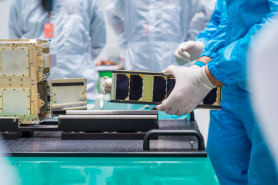
SEOUL, July 06 (AJP) - South Korea's prominent research institute Korea Advanced Institute of Science and Technology (KAIST) announced Sunday the development of a new flexible brain implant that uses micro organic light-emitting diodes (micro-OLEDs) to stimulate neurons with light. The device is expected to offer a safer and more precise tool for treating hard-to-cure brain disorders through a method known as optogenetics.
Optogenetics involves sending light into specific areas of the brain to activate neurons that have been engineered to respond to certain wavelengths. Until now, delivering light deep into the brain has required the use of rigid fiber-optic cables, which can damage soft neural tissue and limit precision. The new micro-OLED implant, developed by Professors Choi Kyung-Cheol and Lee Hyun-Ju's team, offers a flexible, biocompatible alternative that can be inserted into the brain with minimal tissue disruption.
"By focusing on detailed integration processes and improving the implant’s biocompatibility, we aimed to demonstrate that high-resolution and flexible micro-OLEDs could work effectively inside the body," said Dr. Lee So-min, the lead author of the study.

The implant contains eight micro-OLEDs, each of which can be controlled separately. These emit light at a wavelength of 470 nanometers, delivering more than 1 milliwatt per square millimeter, which is considered a high level for neural stimulation. A structural layer known as the pixel define layer prevents electrical interference between the light sources and allows them to operate independently.
One of the main technical hurdles was protecting the sensitive electronics from moisture inside the body. The research team used a thin film encapsulation method, applying alternating layers of aluminum oxide and parylene-C, both known for their stability and safety in medical settings. This protective layer achieved a water vapor transmission rate of 2.66×10⁻⁵ grams per square meter per day, allowing the device to remain functional for more than 10 years inside the body.
The implant’s total width ranges from 260 to 600 micrometers, narrow enough to insert into the brain without the help of external guides like needles or shuttle devices. The team also controlled the stress and thickness of the internal layers to ensure that the device remains flexible even after long-term use.
The research was supported by the National Research Foundation of South Korea and published online on March 26 in Advanced Functional Materials. It was later selected as the journal’s cover story for the July issue.
Copyright ⓒ Aju Press All rights reserved.




